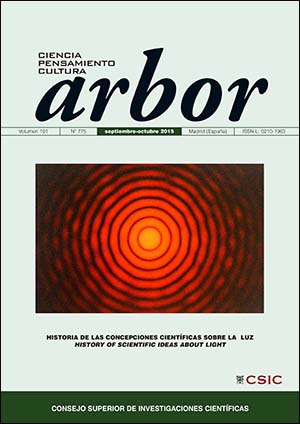Ibn al-Haytham: an optical revolution
DOI:
https://doi.org/10.3989/arbor.2015.775n5001Keywords:
Ibn al-Haytham, History of Optics, intromission theory, refraction, visionAbstract
Ibn al-Haytham (Alhazen) represents a turning point in the history of Optics, as a key figure in the development of optical theory and an outstanding scientist. Here we summarize his main contributions and their significance, with particular emphasis on Ibn al-Haytham’s reconsideration of the role of light in vision and the intromission model he proposed.
Downloads
References
Lejeune, A. (ed.) (1956). L’optique de Claude Ptolémée dans la version latine d’après l’arabe de l’émir Eugène de Sicile. Édition critique et exégétique. Louvain: Publications Universitaires de Louvain.
Lindberg, D. C. (1976). Theories of vision from Al-Kindi to Kepler. Chicago: University of Chicago Press.
Rashed, R. (1997). Histoire des sciences arabes. Tome 2: Mathematiques et Physique. Paris: Éditions du Seuil.
Sabra, A. I. (1994). Optics, Astronomy and Logic. Aldershot.
Sabra, A. I. (ed.) (1989). The Optics of Ibn al- Haytham [Alhacén]. Books I-III: on direct vision. London: The Warburg Institute.
Simon, G. (1988). Le regard, l’être et l’apparence dans l’Optique de l’Antiquité. Paris: Éditions du Seuil.
Smith, A. M. (1999). Ptolemy and the foundations of ancient mathematical optics: a source-based guided study. Philadelphia: American Philosophical Society.
Published
How to Cite
Issue
Section
License
Copyright (c) 2015 Consejo Superior de Investigaciones Científicas (CSIC)

This work is licensed under a Creative Commons Attribution 4.0 International License.
© CSIC. Manuscripts published in both the printed and online versions of this Journal are the property of Consejo Superior de Investigaciones Científicas, and quoting this source is a requirement for any partial or full reproduction.
All contents of this electronic edition, except where otherwise noted, are distributed under a “Creative Commons Attribution 4.0 International” (CC BY 4.0) License. You may read the basic information and the legal text of the license. The indication of the CC BY 4.0 License must be expressly stated in this way when necessary.
Self-archiving in repositories, personal webpages or similar, of any version other than the published by the Editor, is not allowed.














